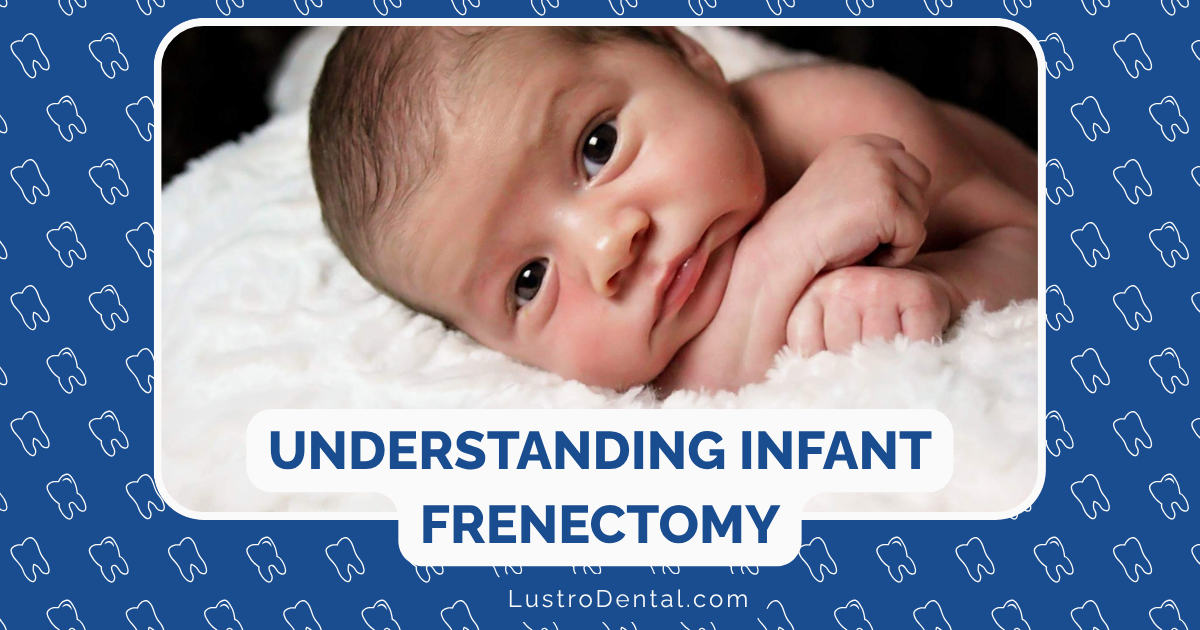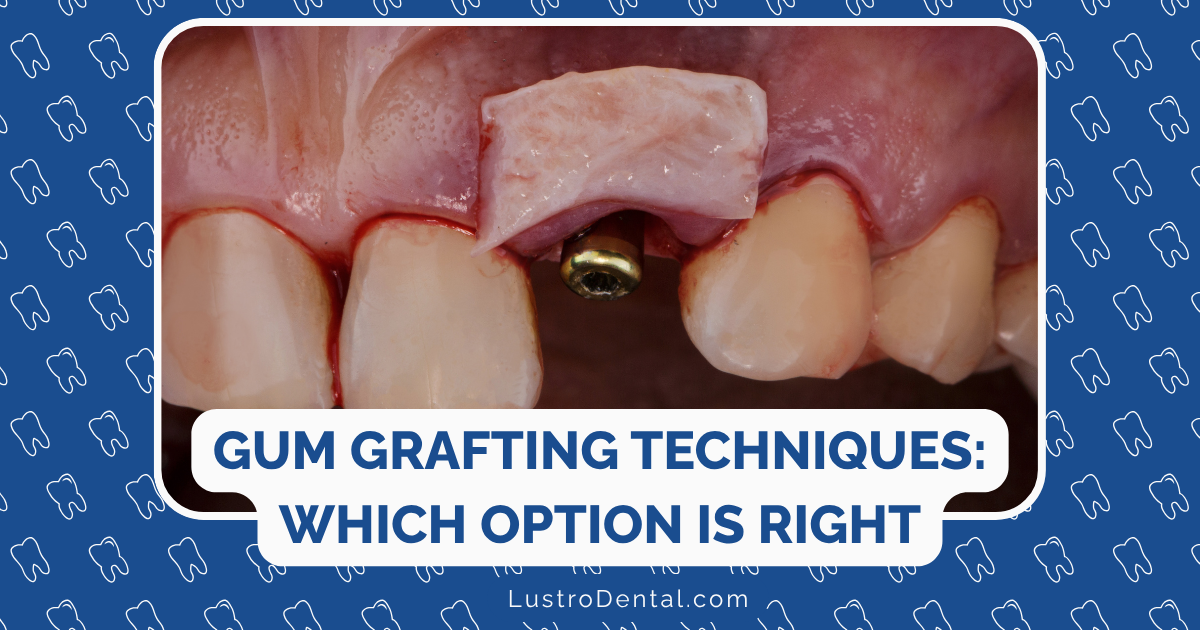Frenectomy for Infants: Addressing Tongue and Lip Ties

When Amanda brought her six-week-old daughter Emma to our practice, she was exhausted and frustrated. “I’ve tried everything,” she explained, fighting back tears. “Emma can’t latch properly, my nipples are cracked and bleeding, and she’s not gaining weight as she should. My lactation consultant suggested she might have a tongue tie, but my pediatrician said it’s not a big deal and we should just keep trying.”
Amanda’s experience reflects the confusion and contradictory advice many parents encounter when facing potential tongue or lip ties in their infants. These oral restrictions can significantly impact feeding, but there’s ongoing debate about when surgical intervention is truly necessary.
In this comprehensive guide, we’ll explore tongue and lip ties in infants—what they are, how to identify them, treatment options including frenectomy, and the important considerations parents should weigh when making decisions about their baby’s care.
Understanding Tongue and Lip Ties: The Basics
What Is a Tongue Tie?
A tongue tie (ankyloglossia) occurs when the thin membrane under the tongue (lingual frenulum) is too short, tight, or thick, restricting the tongue’s normal movement. This restriction can vary from mild to severe and may affect different functions depending on its extent.
According to the American Academy of Pediatrics, tongue ties occur in approximately 4-11% of newborns, with some studies suggesting higher rates. They’re more common in boys than girls and can sometimes run in families.
What Is a Lip Tie?
A lip tie occurs when the tissue (labial frenulum) connecting the upper lip to the gums is too tight or thick, restricting the lip’s movement. Like tongue ties, lip ties vary in severity and impact.
Types and Classification
Tongue ties are typically classified into four types based on where the frenulum attaches to the tongue:
Type 1: Attachment to the tip of the tongue Type 2: Attachment 2-4mm behind the tongue tip Type 3: Attachment to the middle of the tongue Type 4: Attachment to the base of the tongue (submucosal or posterior tie)
Type 4 ties can be particularly challenging to diagnose as they’re less visible but may still significantly impact function.
Lip ties are classified based on where the frenulum attaches to the gum:
Class I: Attachment to the gum above the teeth Class II: Attachment to the gingival tissue Class III: Attachment to the papilla (the triangular piece of gum between teeth) Class IV: Attachment extending into the hard palate
Dr. Sarah Johnson, a pediatric dentist at Mayo Clinic, explains: “The classification is less important than the functional impact. We’re primarily concerned with how the restriction affects feeding, and later, speech and dental development.”
How Tongue and Lip Ties Affect Infants
Breastfeeding Challenges
Tongue and lip ties can significantly impact breastfeeding success, creating challenges for both baby and mother:
For the baby:
- Difficulty achieving and maintaining latch
- Inefficient milk transfer
- Excessive gas and reflux from swallowing air
- Poor weight gain
- Frustration and fatigue during feeding
- Falling asleep at the breast before getting enough milk
For the mother:
- Nipple pain, damage, and trauma
- Incomplete breast drainage
- Recurrent plugged ducts or mastitis
- Decreased milk supply
- Emotional distress and early weaning
Research published in the Journal of Human Lactation indicates that proper identification and treatment of tongue ties can significantly improve breastfeeding outcomes in affected dyads.
Bottle Feeding Challenges
Even bottle-fed babies can experience difficulties with tongue and lip ties:
- Milk leaking from the sides of the mouth
- Excessive air intake leading to gas and reflux
- Longer feeding times
- Difficulty coordinating sucking, swallowing, and breathing
Long-Term Concerns
If left untreated, some tongue and lip ties may lead to:
- Speech articulation difficulties (particularly with sounds requiring tongue elevation like “t,” “d,” “l,” and “r”)
- Dental issues including gaps between front teeth
- Challenges with solid foods
- Poor oral hygiene due to inability to clear food debris
- Potential social impacts related to speech or eating difficulties
It’s important to note that not all ties cause significant problems, and some children naturally adapt or compensate as they grow.
Diagnosing Tongue and Lip Ties: When to Be Concerned
Signs and Symptoms
While some ties are obvious, others can be subtle. Here are key indicators that might suggest a problematic tie:
During feeding:
- Clicking sounds while nursing
- Poor latch that repeatedly slips
- Gumming or chewing of the nipple
- Inability to hold a pacifier
- Excessive drooling
- Gagging or choking during feeds
- Falling asleep quickly at breast due to fatigue
- Frustration and frequent pulling away
Physical signs:
- Heart-shaped tongue tip when extended
- Inability to lift tongue to upper palate
- Inability to extend tongue past gum line
- Tongue that appears notched or dimpled when elevated
- Upper lip that appears tight or immobile
- Significant blanching of the upper lip during feeding
Who Can Diagnose Ties?
Several healthcare providers may be involved in diagnosing tongue and lip ties:
- Pediatricians
- Lactation consultants (IBCLCs)
- Pediatric dentists
- Ear, nose, and throat specialists (ENTs)
- Speech-language pathologists
Dr. Robert Wilson of the American Academy of Pediatric Dentistry notes: “The most accurate assessment comes from combining physical examination with functional evaluation. We need to understand not just how the anatomy looks, but how it’s affecting the baby’s ability to feed effectively.”
The Controversy: Overdiagnosis Concerns
In recent years, there has been growing concern about potential overdiagnosis and unnecessary procedures. A 2020 clinical report from the American Academy of Pediatrics highlighted the need for careful assessment before recommending surgical intervention.
Dr. Lisa Rodriguez, a pediatric otolaryngologist, explains: “We’ve seen a significant increase in frenectomy procedures, but not all ties require surgical correction. It’s important to distinguish between anatomical variation and true functional impairment.”
This controversy underscores the importance of comprehensive evaluation by providers with specific training in infant oral assessment and a team approach to diagnosis.
Treatment Options: Understanding the Choices
Conservative Approaches
Before considering surgical intervention, several non-invasive approaches may be helpful:
Specialized feeding techniques:
- Positioning adjustments
- Deeper latch techniques
- Compression while feeding to assist milk transfer
Bodywork therapies:
- Gentle oral exercises and stretches
- Craniosacral therapy
- Infant massage
- Myofunctional therapy
Lactation support:
- Working with an International Board Certified Lactation Consultant (IBCLC)
- Addressing latch and positioning
- Milk supply management
According to research published in the International Breastfeeding Journal, these conservative approaches may be sufficient for some infants with mild to moderate ties.
Surgical Options: Understanding Frenectomy
When conservative approaches aren’t sufficient, surgical release of the frenulum (frenectomy) may be considered. There are several approaches to this procedure:
Traditional scissors frenectomy:
- Uses sterile surgical scissors to snip the frenulum
- Quick procedure (often less than a minute)
- May or may not require local anesthesia
- Typically has minimal bleeding
Laser frenectomy:
- Uses dental laser to precisely release the frenulum
- Cauterizes as it cuts, reducing bleeding
- May offer more precise control
- Often results in less post-operative discomfort
- May promote faster healing
Electrosurgery:
- Uses electrical current to cut and cauterize
- Reduces bleeding similar to laser
- Less common than scissors or laser approaches
Dr. Michael Chen, a pediatric dentist specializing in laser procedures, notes: “The best technique depends on the provider’s expertise, the specific anatomy of the tie, and the age of the child. Each approach has its advantages, but provider skill is ultimately more important than the specific tool used.”
The Frenectomy Procedure: What Parents Should Know
Before the Procedure
If a frenectomy is recommended for your infant, here’s what typically happens before the procedure:
- Comprehensive consultation: Discussion of benefits, risks, and alternatives
- Feeding assessment: Documentation of current challenges
- Preparation guidance: Instructions for before and after the procedure
- Team coordination: Communication with your lactation consultant or other providers
- Consent process: Written informed consent after all questions are addressed
During the Procedure
The actual frenectomy is typically very quick:
- Positioning: Baby is swaddled or held securely
- Pain management: May include topical anesthetic, though some providers perform the procedure without anesthesia in very young infants
- Release: The frenulum is released using the chosen technique
- Immediate aftercare: Gentle pressure if needed for bleeding
- Comfort: Immediate breastfeeding or skin-to-skin contact is often encouraged
After the Procedure
Post-procedure care is crucial for optimal healing and outcomes:
- Immediate feeding: Often recommended right after the procedure
- Pain management: Typically includes skin-to-skin contact, breastfeeding, and sometimes infant-appropriate pain relievers
- Stretching exercises: Specific exercises to prevent reattachment
- Follow-up care: Appointments with the provider and lactation consultant
- Monitoring: Watching for signs of complications or concerns
According to a study in the Journal of Human Lactation, most infants show improvement in feeding within 24-48 hours after the procedure, though full adjustment may take 1-2 weeks.
Benefits and Risks: Making an Informed Decision
Potential Benefits of Frenectomy
When performed in appropriate cases, frenectomy may offer several benefits:
Immediate benefits:
- Improved latch and milk transfer
- Reduced nipple pain for the mother
- More efficient feeding with less fatigue
- Better weight gain
Long-term benefits:
- Continued breastfeeding success
- Potential prevention of speech issues
- Reduced risk of dental problems
- Improved oral hygiene capability
Research published in the International Journal of Pediatric Dentistry found that 80-90% of mothers reported improved breastfeeding after frenectomy for significant tongue ties.
Potential Risks and Complications
Like any procedure, frenectomy carries some risks:
Common and minor risks:
- Temporary pain or discomfort
- Minor bleeding during or after the procedure
- Reattachment of the frenulum (most common complication)
- Temporary changes in feeding pattern
Rare but serious risks:
- Infection
- Excessive bleeding
- Damage to surrounding tissues or structures
- Scarring that creates new functional problems
- Airway complications (extremely rare)
A systematic review in the International Journal of Pediatric Otorhinolaryngology found that serious complications from infant frenectomy are very rare when performed by experienced providers, with minor bleeding being the most common issue.
Controversies and Considerations: Navigating Conflicting Advice
The Debate Among Medical Professionals
Parents often receive conflicting advice about tongue and lip ties, reflecting genuine debate within the medical community:
Perspectives favoring intervention:
- Early treatment can prevent feeding difficulties and support breastfeeding
- Procedure is minor with low risk when performed properly
- Potential to prevent later speech and dental issues
Perspectives urging caution:
- Not all anatomical variations cause functional problems
- Some ties may resolve or become less problematic with growth
- Insufficient high-quality research on long-term outcomes
- Concerns about unnecessary procedures
Dr. James Wilson of the Academy of Breastfeeding Medicine suggests: “The key is individualized assessment. We need to look beyond simple classification of the anatomy and focus on how it’s affecting function for this specific baby and mother.”
Questions to Ask Before Proceeding
If your healthcare provider suggests a frenectomy, consider asking these questions:
- What specific functional problems is the tie causing?
- How confident are you in the diagnosis?
- What conservative approaches might we try first?
- What type of frenectomy do you recommend and why?
- What is your experience with this procedure?
- What pain management will be used?
- What aftercare will be needed?
- What follow-up support will be provided?
- What improvement should we expect to see and when?
- What are the risks if we decide not to proceed?
Seeking Second Opinions
Given the controversy surrounding this procedure, seeking a second opinion is often wise. Consider consulting:
- A pediatric dentist with specific training in infant oral ties
- A pediatric ENT specialist
- An IBCLC with experience in tongue tie assessment
- A pediatrician with special interest in breastfeeding medicine
Emma’s Journey: A Resolution
Returning to Amanda and Emma from our introduction, their story illustrates the importance of comprehensive assessment. After consultation with a pediatric dentist and IBCLC who both identified a significant posterior tongue tie, Emma underwent a laser frenectomy.
“The procedure itself was quick—less than a minute,” Amanda recalled. “Emma cried briefly but calmed immediately when I nursed her afterward. The difference was noticeable right away. Her latch was deeper, and for the first time, nursing wasn’t painful for me.”
Amanda worked with her lactation consultant on proper latch techniques and performed the recommended stretching exercises to prevent reattachment. Within two weeks, Emma was gaining weight appropriately, and Amanda’s nipple pain had resolved.
“What I wish I’d known earlier is that it’s not just about whether a tie exists anatomically, but how it’s affecting function,” Amanda reflected. “Finding providers who looked at the whole picture made all the difference for us.”
Finding the Right Provider: Key Considerations
If you’re concerned about a possible tongue or lip tie in your infant, finding the right provider is crucial:
Qualities to Look For:
- Specific training and experience with infant oral ties
- Collaborative approach working with lactation consultants
- Willingness to discuss both benefits and risks
- Focus on function rather than appearance alone
- Comprehensive pre- and post-procedure support
- Clear aftercare instructions and availability for follow-up
Where to Start Your Search:
- Referrals from International Board Certified Lactation Consultants
- Pediatric dentists with specialized training
- Pediatric ENT specialists
- Breastfeeding medicine specialists
- Support groups for parents of babies with tongue ties
Conclusion: Balancing Perspectives for Optimal Care
Tongue and lip ties exist on a spectrum, and their impact varies significantly between infants. While frenectomy can be transformative in cases of significant functional impairment, not every anatomical variation requires surgical correction.
The best approach combines:
- Careful functional assessment
- Consideration of conservative approaches
- Collaborative care between specialists
- Informed decision-making by parents
- Appropriate follow-up and support
By focusing on function rather than appearance alone and seeking providers who take a thoughtful, evidence-based approach, parents can navigate this often confusing issue with confidence, ensuring their babies receive appropriate care while avoiding unnecessary procedures.
Remember that feeding challenges can have multiple causes, and tongue or lip ties are just one possibility. A comprehensive evaluation by knowledgeable providers is essential for accurate diagnosis and appropriate treatment recommendations.
Have you navigated tongue or lip tie concerns with your infant? We’d love to hear about your experience in the comments below.







